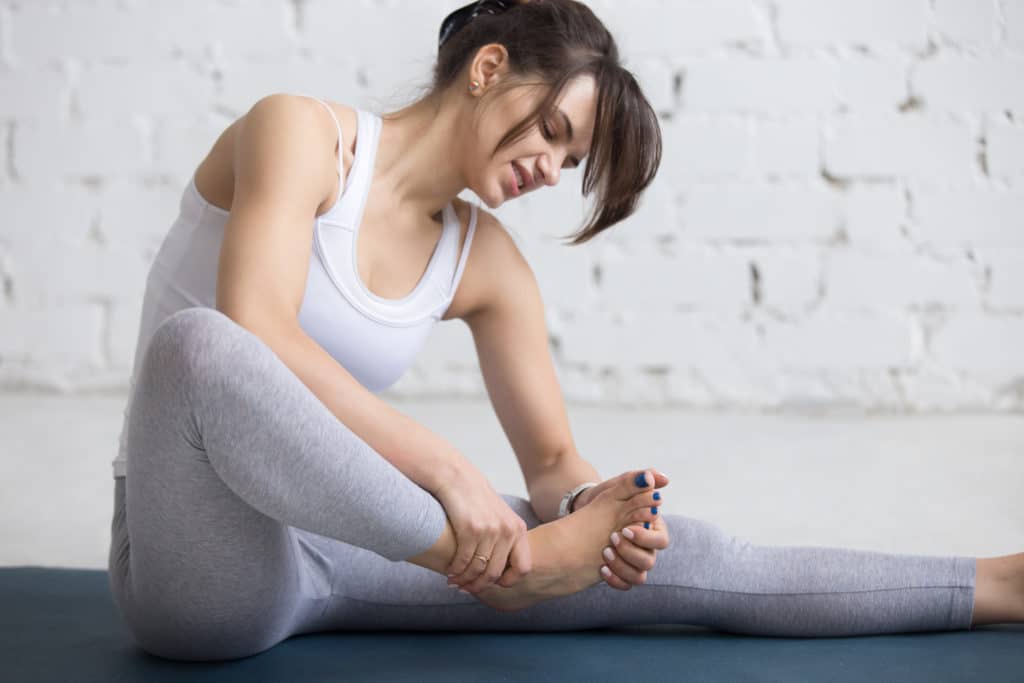Last updated: March 20, 2020

This concern can take the form of
I know of a student doing Yin Yoga who hurt herself while she was coming out of a posture and she had pain for weeks afterwards.
Any injury occurring in a yoga class is regrettable and unfortunate. However, injuries can happen in all walks of life and during any physical activity. Crossing a street is dangerous, but this does not mean we should never cross a road. It does mean that we have to be attentive when doing so. One of the best gifts a yoga teacher can provide her students is training in the ability to recognize when signals are present (i.e., pain!) indicating that an injury may be on the way, and to wisely choose to come out of the pose before the injury occurs.
The number of injuries occurring in yoga classes has been rising all over world.[1] However, also increasing is the sheer number of students practicing yoga. What is important is the rate of injuries occurring during a yoga class versus other forms of physical exercise or therapy. Unfortunately, here too the numbers seem to point to injury rates in yoga classes that match or exceed those in sports. A report on a 2017 study[2] found
… the incidence of pain caused by yoga is more than 10 per cent per year, which is comparable to the injury rate of all sports injuries combined among the physically active population. However people consider it to be a very safe activity. This injury rate is up to 10 times higher than has previously been reported.
We also found that yoga can exacerbate existing pain, with 21 per cent of existing injuries made worse by doing yoga, particularly pre-existing musculoskeletal pain in the upper limbs.
In terms of severity, more than one-third of cases of pain caused by yoga were serious enough to prevent yoga participation and lasted more than 3 months.
The study found that most “new” yoga pain was in the upper extremities (shoulder, elbow, wrist, hand) possibly due to downward dog and similar postures that put weight on the upper limbs.[3]
That all sounds very bad, but they also reported,
…74 per cent of participants in the study reported that existing pain was improved by yoga, highlighting the complex relationship between musculoskeletal pain and yoga practice.[4]
Unfortunately, the authors did not distinguish between various styles of yoga. From their mention of downward dog, they are probably not referring to restorative yoga or Yin Yoga, as these styles do not incorporate weight bearing postures. It seems logical to assume that the more vigorous and active practices create more injuries than the more passive styles.
It is curious to review the findings of the 2016 American study cited earlier that showed where the most common injuries occurred and to whom:
The trunk (46.6%) was the most frequent region injured, and sprain/strain (45.0%) accounted for the majority of diagnoses. The injury rate increased overall from 2001 to 2014, and it was greatest for those aged 65 years and older (57.9/100,000) compared with those aged 18 to 44 years (11.9/100,000) and 45 to 64 years (17.7/100,000) in 2014.[5]
This would indicate that the older the student, the more care should be taken. These authors concluded,
Participants aged 65 years and older have a greater rate of injury from practicing yoga when compared with other age groups … While there are many health benefits to practicing yoga, participants and those wishing to become participants should confer with a physician prior to engaging in physical activity and practice only under the guidance of certified instructors.[6]
This conclusion is similar to the one reached by the authors of the 2017 study,
Pain caused by yoga might be prevented by careful performance and participants telling their yoga teachers of injuries they may have prior to participation, as well as informing their healthcare professionals about their yoga practice. We recommend that yoga teachers also discuss with their students the risks for injury if not practiced conscientiously, and the potential for yoga to exacerbate some injuries.[7]
Sage advice: yoga teachers should not be over-promising the benefits of the practice and should be training students to be attentive to the warning signs that they may be going too far. This applies to Yin Yoga, for sure, but to all styles of yoga as well.
Return to Topics
[1] A 2016 study in the United States found an increase in the rate of injuries of yoga practitioners between 2001 and 2014. There were 29,590 yoga-related injuries seen in hospital emergency departments from 2001 to 2014. (See Thomas A. Swain and Gerald McGwin, “Yoga-Related Injuries in the United States From 2001 to 2014,” The Orthopaedic Journal of Sports Medicine (2016).)
A more recent, 2020 Australian study found “There were 118 yoga-related injury cases that significantly (p < .05) increased by 357% from July 2009 to June 2016. Most of the cases were female (n = 96; 81.4%) and between 20 and 39 years old (n = 68, 57.6%). Most common injuries comprised dislocations/sprains/strains (n = 60, 51.7%) followed by fractures (n = 17, 14.4%), and injury to muscle/tendon (n = 15, 12.7%).” B. Sekendiz, “An Epidemiological Analysis of Yoga-Related Injury Presentations to Emergency Departments in Australia,” The Physician and Sportsmedicine (January 17, 2020).
[2] See Marc Campo, Mariya P. Shiyko, Mary Beth Kean, Lynne Roberts and Evangelos Pappas, “Musculoskeletal pain associated with recreational yoga participation: A prospective cohort study with 1-year follow-up,” Journal of Bodywork and Movement Therapies 22.2 (April 2018): 418–423.
[3] University of Sydney, “Yoga might be more risky for causing musculoskeletal pain than you think,” Science Daily (June 27, 2017).
[4] Ibid.
[5] Swain et al., “Yoga-Related Injuries in the United States From 2001 to 2014.”
[6] University of Sydney, “Yoga might be more risky for causing musculoskeletal pain than you think.”
[7] Marc Campo et al., “Musculoskeletal pain associated with recreational yoga participation: A prospective cohort study with 1-year follow-up.”
